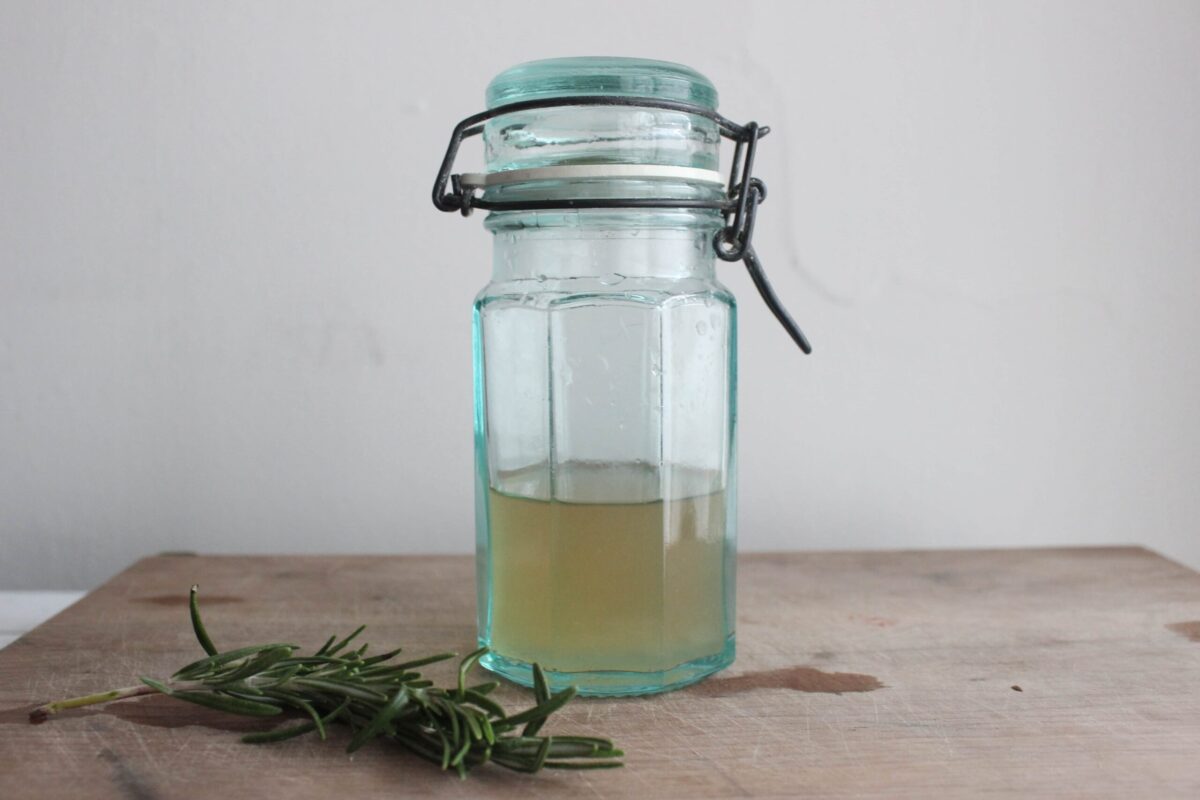Ingredients
Equipment
Method
- Fully sterilise the glass jar and lid.
- Chop up the rosemary to maximise the surface area of the herb that will be exposed to the alcohol.
- Add the fresh rosemary or dry herb to your glass jar. If you’re using fresh rosemary, you should use enough to fill the jar about ¾ of the way full. If you’re using dry rosemary, you should fill the jar about halfway, to leave enough room for the herb to expand when it absorbs the alcohol.
- Submerge the rosemary completely in the alcohol.
- Tighten the lid on your jar. Again, if you’re using a metal lid, add a small piece of parchment paper between the lid and your mixture to avoid corroding the metal.
- Set in a cool, dark place for 6-8 weeks. Shake it a few times per week to ensure the rosemary remains completely submerged in the alcohol.
- After 8 weeks, use a fine mesh strainer or cheesecloth to strain off the tincture. Using cheesecloth will work best for dry rosemary because it will prevent small pieces of the herb from remaining in your tincture.
- Make sure all of the rosemary has been removed from the alcohol before storing the tincture. If you don’t the herbs will eventually develop a smell and spoil the tincture.
- Use a small funnel to pour the tincture into the small glass amber bottle. Store the bottle in a cool, dark place away from sunlight.
- Make sure to label and date the tincture so you know what it is (tincture making can easily become addictive and if you don’t label your work, you’ll soon have 20 anonymous amber glass dropper bottles lining your shelves!)
Notes
- Tincture for your hair - If you’re planning to use this tincture for your hair, consider swapping alcohol for apple cider vinegar. Apple cider vinegar’s acidic nature helps to balance the pH levels of the scalp, which can relieve itchiness, dryness, and dandruff. Vinegar can also help to remove buildup from styling products and hard water minerals, which can help to leave your hair shinier and smoother. Apple cider vinegar also has antimicrobial properties which can help to combat scalp infections and improve overall scalp health. Combined with rosemary, it’s a powerful and healing natural hair remedy.
How long does rosemary tincture last?
Rosemary tincture can last between 4-5 years if stored in a cool, dark place. To ensure it lasts a long time, make sure to remove all of the plant material when straining off the tincture. Leaving small pieces of herb in the bottle will cause it to go bad more quickly.How to use rosemary tincture?
- Internally - the quickest way to ingest the medical benefits of this tincture is to add some under your tongue. I like to use the dropper that comes with the amber dropper bottles to do this.
- Topically - add a dropper full of the tincture to a tablespoon of coconut oil. Mix it up and rub into directly onto sore muscles and joints for natural pain relief.
- To promote hair growth - add about one dropper full of the rosemary extract per cup (or 8 oz) to your favourite shampoo or conditioner. Then use your shampoo or conditioner as normal to enjoy the benefits that rosemary offers for hair growth.
- In your favourite cocktail - add a few drops to your favourite cocktail for a warming, holiday flavour (people have raved about rosemary tincture tasting wonderful in a gin fizz!)
- As an antibacterial mouthwash - add a few drops of rosemary tincture to a cup of water and use it as a mouthwash to help fight bacteria and freshen your breath.
- A stress relief aid - simply inhale the aroma of rosemary tincture or add a dropper full to a bath to help reduce stress and promote relaxation.
- As a natural skin toner - add a few drops of rosemary tincture to a small spray bottle. Top up the bottle with distilled water and give it a shake. Use it as a natural toner for your skin to help tighten pores and reduce oiliness.
- As a room spray - in a small spray bottle, mix a dropper full of tincture with one part water and one part witch hazel. Use the spray as a nontoxic room spray to promote a restful environment in your home.
